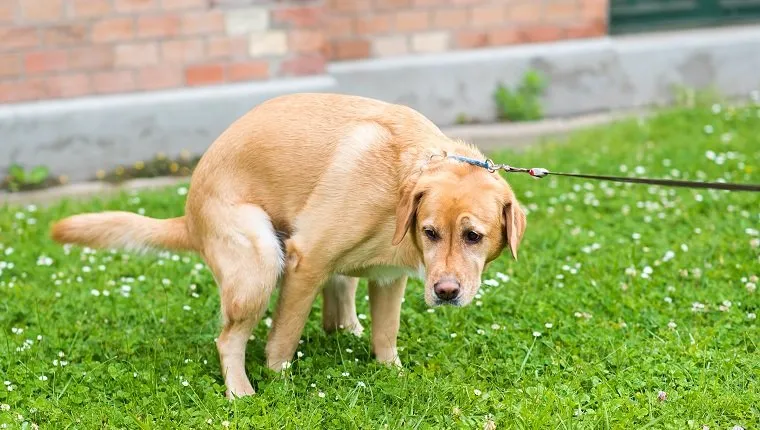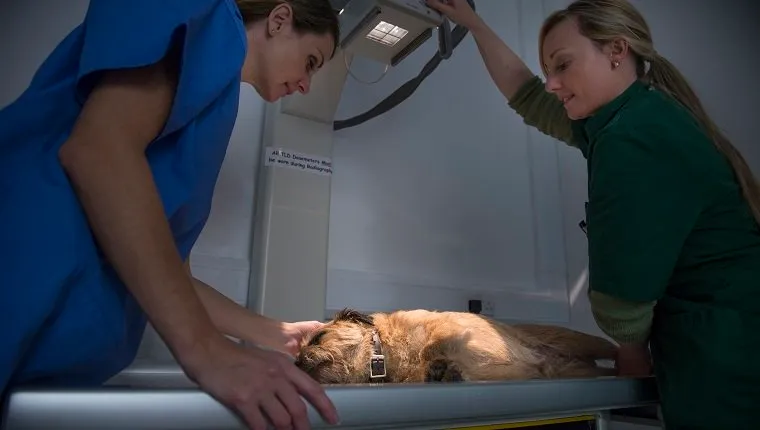Prostate cancer in dogs is a rare but deadly form of cancer that can easily metastasize and spread to other organs and areas of the body, including the lungs, bones, and lymph nodes. It can affect both neutered and non-neutered male dogs of any breed, though it’s more common in large breeds and older dogs around nine or ten years of age.
The prostate is a gland located behind the bladder and below the rectum, and it aids in semen production. When tumors grow in the prostate, they can put pressure on surrounding organs, resulting in a variety of symptoms. Most prostate cancer is known as adenocarcinoma, which is highly aggressive.
Sometimes adenocarcinoma symptoms are similar to those of other forms of cancer, and it may be difficult to distinguish which type of cancer a dog is suffering from. Carcinoma, fibrosarcoma, leiomyosarcoma, and squamous cell carcinoma are other types of cancer that can affect the prostate.
If you see the signs of prostate cancer in your dog, it is important that you consult your veterinarian right away so they can form a proper diagnosis and begin treatment. Here’s what you should know about the symptoms, causes, and treatments for prostate cancer in dogs.
Symptoms Of Prostate Cancer In Dogs

The symptoms of prostate cancer in dogs can develop gradually over time as the condition progresses. Often, urination and defecation are affected due to the prostate’s close proximity to the urinary tract and the rectum.
Dogs who suffer from prostate cancer may exhibit mild or severe symptoms, but will usually show one or more of the following signs:
- Straining to urinate or defecate
- Decreased urination
- Incontinence
- Constipation
- Blood in urine
- Pain, especially around the area of the prostate
- Holding the tail in unusual positions
- Scooting the anus
- Ribbon-like stool
- Abnormal posture or gait
- Hunched back
- Loss of appetite
- Weight loss
- Fever
- Difficulty breathing
- Watery or bloody discharge from the penis
- Lameness
- Lethargy
- Reluctance to move or exercise
Causes Of Prostate Cancer In Dogs

The causes of prostate cancer in dogs are not well understood. When the cause of the condition is unknown, it is referred to as idiopathic, and this is usually the case.
Hormonal imbalance may also be a cause of prostate cancer. Larger breed dogs are more at risk, and both intact males and neutered males can suffer from prostate cancer.
Instances of adenocarcinoma are generally thought to be higher in neutered animals, but other prostate conditions that can be precancerous, such as benign prostatic hyperplasia (BPH), are more common in dogs that have not been neutered.
Diagnosis Of Prostate Cancer In Dogs

Diagnosis of prostate cancer in dogs may be difficult, as symptoms of the condition share much in common with other forms of cancer, or even less serious conditions such as urinary tract infections. Sometimes it can go undiagnosed until it reaches an advanced stage and starts to metastasize.
Veterinarians usually check prostate health, especially in older males, with palpitations and a physical examination. They can usually detect irregularities in the prostate gland or masses in the abdomen.
Further tests, including urinalysis, contrast X-rays, ultrasound scans, and biopsies, may follow.
Ultrasound helps determine if the prostate is swollen or has polyps, cysts, or tumors. It does not tell whether the tumor is cancerous, so veterinarians will often take a biopsy of the rectal wall. This helps them figure out if the tumor is malignant and what kind of cancer it is.
X-rays can be used to find out if the cancer has metastasized or spread to other areas of the body.
Treatment For Prostate Cancer In Dogs

Surgery to remove the prostate gland may be an effective method of treatment for dogs with prostate cancer and can even cure the condition. However, it’s risky and only possible if the cancer has not spread to other areas of the body.
This surgery can cause major complications and leave dogs incontinent, and because prostate cancer metastasizes so easily, most dogs are not candidates for the procedure. Neutering is generally not effective in treating prostate cancer.
The most common effective treatment for prostate cancer in dogs is a combination of NSAIDs, chemotherapy, and radiation therapy. This can increase survival time an average of 20 months.
Incontinence, gastrointestinal toxicosis, or genitourinary toxicosis can be side effects of this treatment. If your dog is diagnosed with prostate cancer, then you should discuss treatment options with your veterinarian and determine what is the best course of action for your dog.
Do you keep up with regular vet visits to find any health problems like cancer early? What are your tips for keeping dogs healthy? Let us know in the comments below!









